Study on Dynamic Disaster Mechanisms of Thick Hard Roof Induced by Hydraulic Fracturing in Surface Vertical Well
Abstract
:1. Introduction
2. Case of Mine Dynamic Disaster Induced by Vertical Ground Well Hydraulic Fracturing in Thick Hard Roof
2.1. Working Face Overview of a Mine in Shandong
2.2. Overview of Vertical Ground Well Hydraulic Fracturing in 6306 Working Face
2.3. Basic Situation of ‘11.30’ Mine Earthquake in 6306 Working Face of a Mine in Shandong
2.4. Analysis of Monitoring Data before and after ‘11.30’ Mine Earthquake
3. Similar Material Simulation Test Study on Dynamic Disaster of Thick Hard Roof Induced by Water Pressure Fracturing in Vertical Well
3.1. Simulation Test Scheme of Similar Material
3.2. Movement Law of Overlying Strata in Coal Seam Mining before Hydraulic Fracturing of Surface Vertical Well
3.3. Movement Law of Overlying Strata after Hydraulic Fracturing of Vertical Ground Well
3.4. Vertical Displacement Monitoring Results of Similar Material Simulation Test
3.5. Stress Monitoring Results of Similar Material Simulation Test
4. Study on Dynamic Disaster Mechanism of Thick Hard Roof Induced by Water Pressure Fracturing in Vertical Well
4.1. Estimation of Advanced Abutment Pressure in Coal Seam Mining before Hydraulic Fracturing of Vertical Surface Well
4.2. Estimation of Advanced Abutment Pressure in Coal Seam Mining after Hydraulic Fracturing of Super Thick Hard Roof in Vertical Well
4.3. Study on Dynamic Disaster Mechanism of Thick Hard Roof Induced by Hydraulic Fracturing in Vertical Well
5. Technical Optimization Scheme of Ground Hydraulic Fracturing Thick Hard Roof
5.1. Optimization Scheme of Hydraulic Fracturing Technology for Thick Hard Roof in Vertical Surface Well
5.2. Optimization Scheme of Hydraulic Fracturing Technology for Thick Hard Roof in Surface Horizontal Well
6. Conclusions
Author Contributions
Funding
Data Availability Statement
Acknowledgments
Conflicts of Interest
References
- Xue, L.; Zhang, W.; Zheng, Z.; Liu, Z.; Meng, S.; Li, H.; Du, Y. Measurement and influential factors of the efficiency of coal resources of China’s provinces: Based on Bootstrap-DEA and Tobit. Energy 2021, 221, 119763. [Google Scholar] [CrossRef]
- Vallejos, J.A.; McKinnon, S.D. Correlations between mining and seismicity for re-entry protocol development. Int. J. Rock Mech. Min. Sci. 2011, 48, 616–625. [Google Scholar] [CrossRef]
- Cai, W.; Dou, L.; Si, G.; Hu, Y. Fault-Induced Coal Burst Mechanism under Mining-Induced Static and Dynamic Stresses. Engineering 2021, 7, 687–700. [Google Scholar] [CrossRef]
- Li, T.; Cai, M.F.; Cai, M. A review of mining-induced seismicity in China. Int. J. Rock Mech. Min. Sci. 2007, 44, 1149–1171. [Google Scholar] [CrossRef]
- Yu, W.; Pan, B.; Zhang, F.; Yao, S.; Liu, F. Deformation Characteristics and Determination of Optimum Supporting Time of Alteration Rock Mass in Deep Mine. KSCE J. Civ. Eng. 2019, 23, 4921–4932. [Google Scholar] [CrossRef]
- Wang, B.; Sun, K.; Liang, B.; Chi, H. Experimental research on the mechanical character of deep mining rocks in THM coupling condition. Energy Sources Part A Recovery Util. Environ. Eff. 2019, 43, 1660–1674. [Google Scholar] [CrossRef]
- Tang, S.; Li, J.; Ding, S.; Zhang, L. The influence of water-stress loading sequences on the creep behavior of granite. Bull. Eng. Geol. Environ. 2022, 81, 482. [Google Scholar] [CrossRef]
- Liang, X.; Tang, S.; Tang, C.A.; Hu, L.; Chen, F. Influence of Water on the Mechanical Properties and Failure Behaviors of Sandstone Under Triaxial Compression. Rock Mech. Rock Eng. 2022, 81, 141. [Google Scholar] [CrossRef]
- Wang, Q.; Jiang, B.; Xu, S.; He, M.; Jiang, Z.; Li, S.; Wei, H.; Xiao, Y. Roof-cutting and energy-absorbing method for dynamic disaster control in deep coal mine. Int. J. Rock Mech. Min. Sci. 2022, 158, 105186. [Google Scholar] [CrossRef]
- Wang, Q.; Xu, S.; Xin, Z.; He, M.; Wei, H.; Jiang, B. Mechanical properties and field application of constant resistance energy-absorbing anchor cable. Tunn. Undergr. Space Technol. 2022, 125, 104526. [Google Scholar] [CrossRef]
- Yin, Q.; Wu, J.; Jiang, Z.; Zhu, C.; Su, H.; Jing, H.; Gu, X. Investigating the effect of water quenching cycles on mechanical behaviors for granites after conventional triaxial compression. Geomech. Geophys. Geo-Energy Geo-Resour. 2022, 8, 77. [Google Scholar] [CrossRef]
- Wang, Y.; Zhu, C.; He, M.C.; Wang, X.; Le, H.L. Macro-meso dynamic fracture behaviors of Xinjiang marble exposed to freeze thaw and frequent impact disturbance loads: A lab-scale testing. Geomech. Geophys. Geo-Energy Geo-Resour. 2022, 8, 154. [Google Scholar] [CrossRef]
- Wen, J.; Li, H.; Jiang, F.; Yu, Z.; Ma, H.; Yang, X. Rock burst risk evaluation based on equivalent surrounding rock strength. Int. J. Min. Sci. Technol. 2019, 29, 571–576. [Google Scholar] [CrossRef]
- Chen, G.; He, M.; Fan, F. Rock burst analysis using DDA numerical simulation. Int. J. Geomech. 2018, 18, 04018001. [Google Scholar] [CrossRef]
- Wei, C.; Zhang, C.; Canbulat, I.; Cao, A.; Dou, L. Evaluation of current coal burst control techniques and development of a coal burst management framework. Tunn. Undergr. Space Technol. 2018, 81, 129–143. [Google Scholar] [CrossRef]
- Wang, S.; Zhu, G.; Zhang, K.; Yang, L.; Zhang, G. Study on Characteristics of Mining Earthquake in Multicoal Seam Mining under Thick and Hard Strata in High Position. Shock Vib. 2021, 2021, 6675089. [Google Scholar] [CrossRef]
- Zhang, M.; Hu, X.; Huang, H.; Chen, G.; Gao, S.; Liu, C.; Tian, L.; Zhang, G. Mechanism and Prevention and Control of Mine Earthquake in Thick and Hard Rock Strata considering the Horizontal Stress Evolution of Stope. Shock Vib. 2021, 2021, 6680928. [Google Scholar] [CrossRef]
- He, H.; Dou, L.; Cao, A.; Fan, J. Mechanisms of Mining Seismicity under Large Scale Exploitation with Multikey Strata. Shock Vib. 2015, 2015, 313069. [Google Scholar] [CrossRef] [Green Version]
- Li, X.; Kim, E.; Walton, G. A study of rock pillar behaviors in laboratory and in-situ scales using combined finite-discrete element method models. Int. J. Rock Mech. Min. Sci. 2019, 118, 21–32. [Google Scholar] [CrossRef]
- Guo, W.; Li, Y.; Yin, D.; Zhang, S.; Sun, X. Mechanisms of rock burst in hard and thick upper strata and rock-burst controlling technology. Arab. J. Geosci. 2016, 9, 561. [Google Scholar] [CrossRef]
- Sinha, S.; Walton, G. Understanding continuum and discontinuum models of rock-support interaction for excavations undergoing stress-induced spalling. Int. J. Rock Mech. Min. Sci. 2019, 123, 104089. [Google Scholar] [CrossRef]
- Lyu, P.; Bao, X.; Gang, L.; Chen, X. Research on Fault Activation Law in Deep Mining Face and Mechanism of Rock Burst Induced by Fault Activation. Adv. Civ. Eng. 2020, 2020, 8854467. [Google Scholar]
- Lyu, P.; Lu, J.; Wang, E.; Chen, X. The Mechanical Criterion of Activation and Instability of Normal Fault Induced by the Movement of Key Stratum and Its Disaster-Causing Mechanism of Rock Burst in the Hanging Wall Mining. Adv. Civ. Eng. 2021, 2021, 6618957. [Google Scholar]
- Ning, J.; Wang, J.; Jiang, L.; Jiang, N.; Liu, X.; Jiang, J. Fracture analysis of double-layer hard and thick roof and the controlling effect on strata behavior: A case study. Eng. Fail. Anal. 2017, 81, 117–134. [Google Scholar] [CrossRef]
- Perrin, C.; Manighetti, I.; Ampuero, J.P.; Cappa, F.; Gaudemer, Y. Location of largest earthquake slip and fast rupture controlled by along-strike change in fault structural maturity due to fault growth. J. Geophys. Res. Solid Earth 2016, 121, 3666–3685. [Google Scholar] [CrossRef] [Green Version]
- Xiao, Y.; Feng, X.; Hudson, J.A.; Chen, B.; Feng, G.; Liu, J. ISRM Suggested Method for In Situ Micro seismic Monitoring of the Fracturing Process in Rock Masses. Rock Mech. Rock Eng. 2015, 49, 343–369. [Google Scholar] [CrossRef]
- Xie, H.; Gao, M.; Zhang, R.; Peng, G.; Wang, W.; Li, A. Study on the Mechanical Properties and Mechanical Response of Coal Mining at 1000 m or Deeper. Rock Mech. Rock Eng. 2018, 52, 1475–1490. [Google Scholar] [CrossRef]
- Xie, H.; Li, C.; He, Z.; Li, C.; Lu, Y.; Zhang, R.; Gao, M.; Gao, F. Experimental study on rock mechanical behavior retaining the in situ geological conditions at different depths. Int. J. Rock Mech. Min. Sci. 2021, 138, 503. [Google Scholar] [CrossRef]
- Yang, Z.; Liu, C.; Zhu, H.; Xie, F.; Dou, L.; Chen, J. Mechanism of rock burst caused by fracture of key strata during irregular working face mining and its prevention methods. Int. J. Min. Sci. Technol. 2019, 29, 889–897. [Google Scholar] [CrossRef]
- Yu, B.; Zhang, Z.; Kuang, T.; Liu, J. Stress Changes and Deformation Monitoring of Longwall Coal Pillars Located in Weak Ground. Rock Mech. Rock Eng. 2016, 49, 3293–3305. [Google Scholar] [CrossRef]
- Yu, B.; Zhao, J.; Xiao, H. Case Study on Overburden Fracturing during Longwall Top Coal Caving Using Micro seismic Monitoring. Rock Mech. Rock Eng. 2016, 50, 507–511. [Google Scholar] [CrossRef]
- Yu, Z.; Zhu, S.; Wu, Y.; Yu, H. Study on the structural characteristics of the overburden under thick loose layer and thin-bed rock for safety of mining coal seam. Environ. Earth Sci. 2019, 79, 9–18. [Google Scholar] [CrossRef]
- Xie, G.-X.; Yuan, A.; Wang, L.; Liu, X. Study on Deflection of Surrounding Rock Force Chain and Disaster Mechanism of Instability in Deep Stope. Shock Vib. 2020, 2020, 8883897. [Google Scholar] [CrossRef]
- Jiao, Y.-Y.; Wu, K.; Zou, J.; Zheng, F.; Zhang, X.; Wang, C.; Li, X.; Zhang, C. On the strong earthquakes induced by deep coal mining under thick strata-a case study. Geomech. Geophys. Geo-Energy Geo-Resour. 2021, 7, 749–757. [Google Scholar] [CrossRef]
- Li, Y.; Deng, H.; Wen, L.; Qin, Y.; Xu, X. Method for Identifying and Forecasting Mining-Induced Earthquakes Based on Spatiotemporal Characteristics of Micro seismic Activities in Fankou Lead/Zinc Mine. Minerals 2022, 12, 52–63. [Google Scholar]
- Xue, R.; Liang, Z.; Xu, N. Rockburst prediction and analysis of activity characteristics within surrounding rock based on micro seismic monitoring and numerical simulation. Int. J. Rock Mech. Min. Sci. 2021, 142, 104750. [Google Scholar] [CrossRef]
- Guo, P.; Li, J.; Hao, X.; Cui, H.; Tian, L.; Xie, W.; Chu, J.; Teng, B. Influence of Mine Earthquake Disturbance on the Principal Stress of the Main Roadway near the Goaf and Its Prevention and Control Measures. Geofluids 2021, 2021, 1968846. [Google Scholar] [CrossRef]
- Bai, Q.; Konietzky, H.; Ding, Z.; Cai, W.; Zhang, C. A displacement-dependent moment tensor method for simulating fault-slip induced seismicity. Geomech. Geophys. Geo-Energy Geo-Resour. 2021, 7, 6760–6779. [Google Scholar] [CrossRef]
- Zhang, X.; Zhang, H.; Wei, C.; Feng, G. Numerical Simulation Study on the Influence of Mine Earthquake on the Bolt Stress. Shock Vib. 2021, 2021, 6364718. [Google Scholar] [CrossRef]
- Pilecka, E.; Stec, K.; Chodacki, J.; Pilecki, Z.; Szermer-Zaucha, R.; Krawiec, K. The Impact of High-Energy Mining-Induced Tremor in a Fault Zone on Damage to Buildings. Energies 2021, 14, 4112. [Google Scholar] [CrossRef]
- Cao, X.; Cao, X.; Han, T.; Feng, G.L. Seismic Response Analysis of Deep Underground Roadways and Coal Pillars under the Influence of the Adjacent Goaf. Adv. Civ. Eng. 2021, 2021, 5539628. [Google Scholar] [CrossRef]
- Yu, B.; Gao, R.; Kuang, T.; Huo, B.; Meng, X. Engineering study on fracturing high-level hard rock strata by ground hydraulic action. Tunn. Undergr. Space Technol. 2019, 86, 156–164. [Google Scholar] [CrossRef]
- Ge, Z.; Mei, X.; Lu, Y.; Tang, J.; Xia, B. Optimization and application of sealing material and sealing length for hydraulic fracturing borehole in underground coal mines. Arab. J. Geosci. 2014, 8, 3477–3490. [Google Scholar] [CrossRef]
- Figueiredo, B.; Tsang, C.F.; Rutqvist, J.; Niemi, A. Study of hydraulic fracturing processes in shale formations with complex geological settings. J. Pet. Sci. Eng. 2017, 152, 361–374. [Google Scholar] [CrossRef] [Green Version]
- He, H.; Dou, L.; Fan, J.; Du, T.; Sun, X. Deep-hole directional fracturing of thick hard roof for rockburst prevention. Tunn. Undergr. Space Technol. 2012, 32, 34–43. [Google Scholar] [CrossRef]
- Lu, Y.; Cheng, L.; Ge, Z.; Xia, B.; Li, Q.; Chen, J. Analysis on the Initial Cracking Parameters of Cross-Measure Hydraulic Fracture in Underground Coal Mines. Energies 2015, 8, 6977–6994. [Google Scholar] [CrossRef]
- Fan, C.; Wen, H.; Li, S.; Bai, G.; Zhou, L. Coal seam gas extraction by integrated drillings and punchings from floor roadway considering hydraulic-mechanical coupling effect. Geofluids 2022, 2022, 5198227. [Google Scholar] [CrossRef]
- Fan, C.; Li, S.; Luo, M.; Du, W.; Yang, Z. Coal and gas outburst dynamic system. Int. J. Min. Sci. Technol. 2017, 27, 49–55. [Google Scholar] [CrossRef]
- Marsden, H.; Basu, S.; Striolo, A.; MacGregor, M. Advances of nanotechnologies for hydraulic fracturing of coal seam gas reservoirs: Potential applications and some limitations in Australia. Int. J. Coal Sci. Technol. 2022, 9, 27. [Google Scholar] [CrossRef]
- Gao, R.; Kuang, T.; Zhang, Y.; Zhang, W.; Quan, C. Controlling mine pressure by subjecting high-level hard rock strata to ground fracturing. Int. J. Coal Sci. Technol. 2021, 8, 1336–1350. [Google Scholar] [CrossRef]
- Zhu, Z.; Wu, Y.; Han, J. A Prediction Method of Coal Burst Based on Analytic Hierarchy Process and Fuzzy Comprehensive Evaluation. Front. Earth Sci. 2022, 9, 834958. [Google Scholar] [CrossRef]
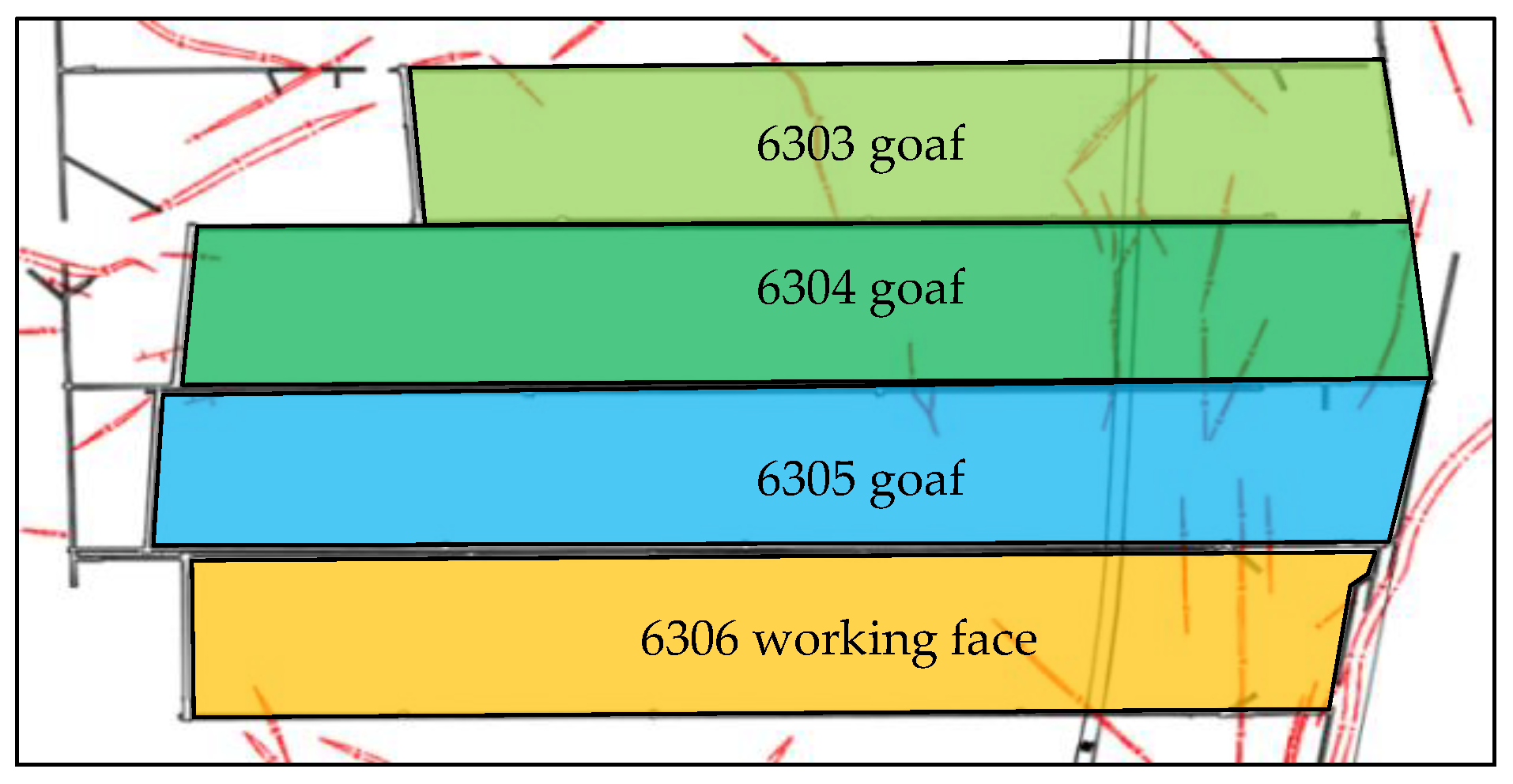
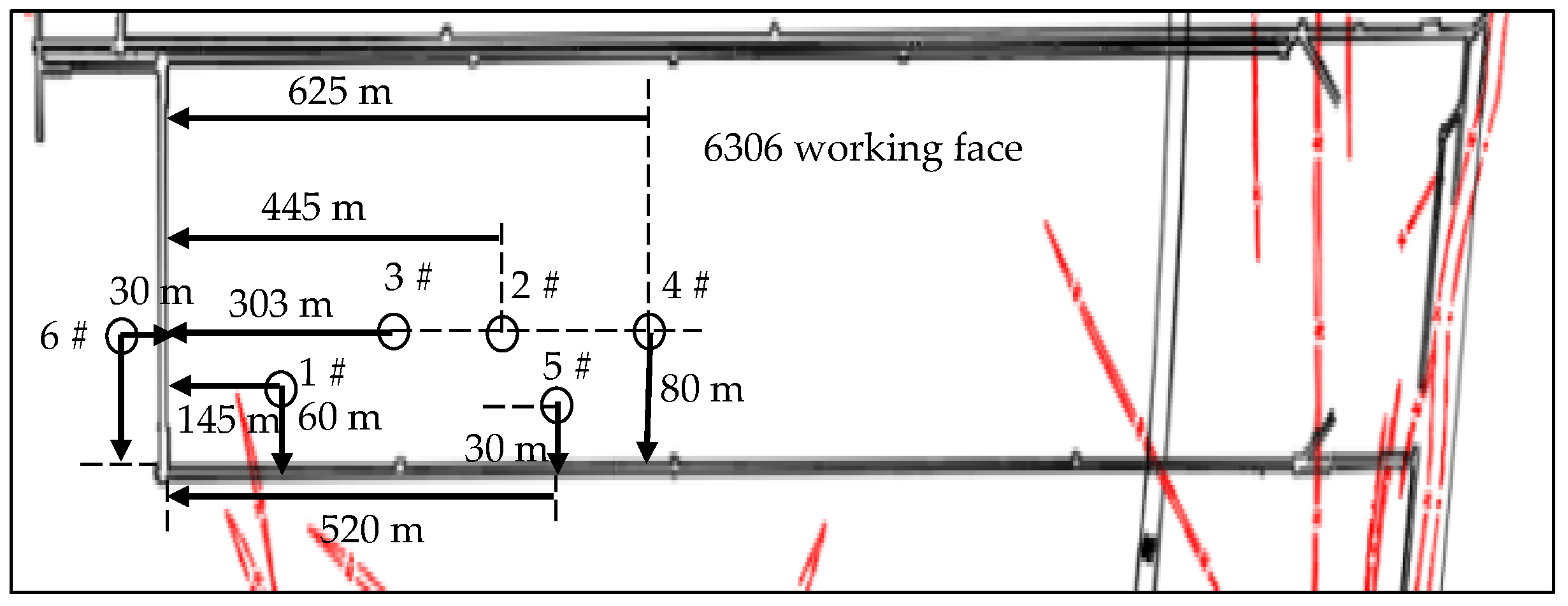
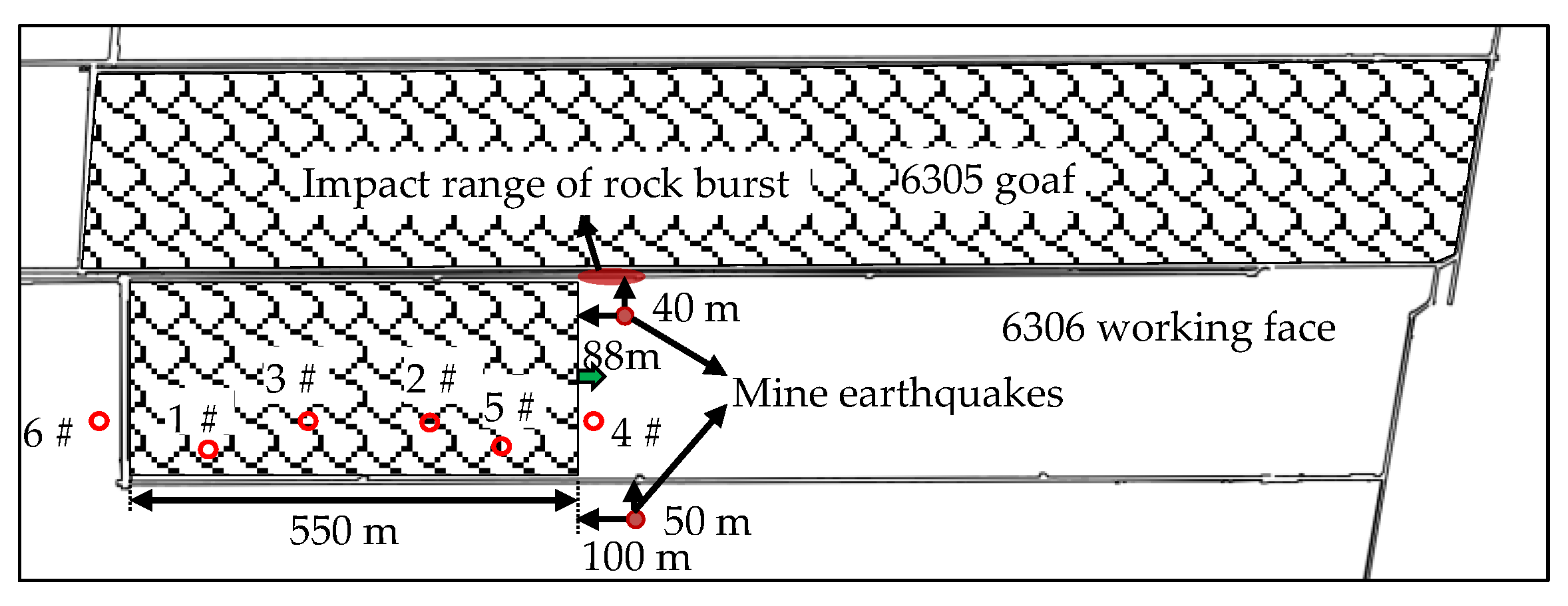
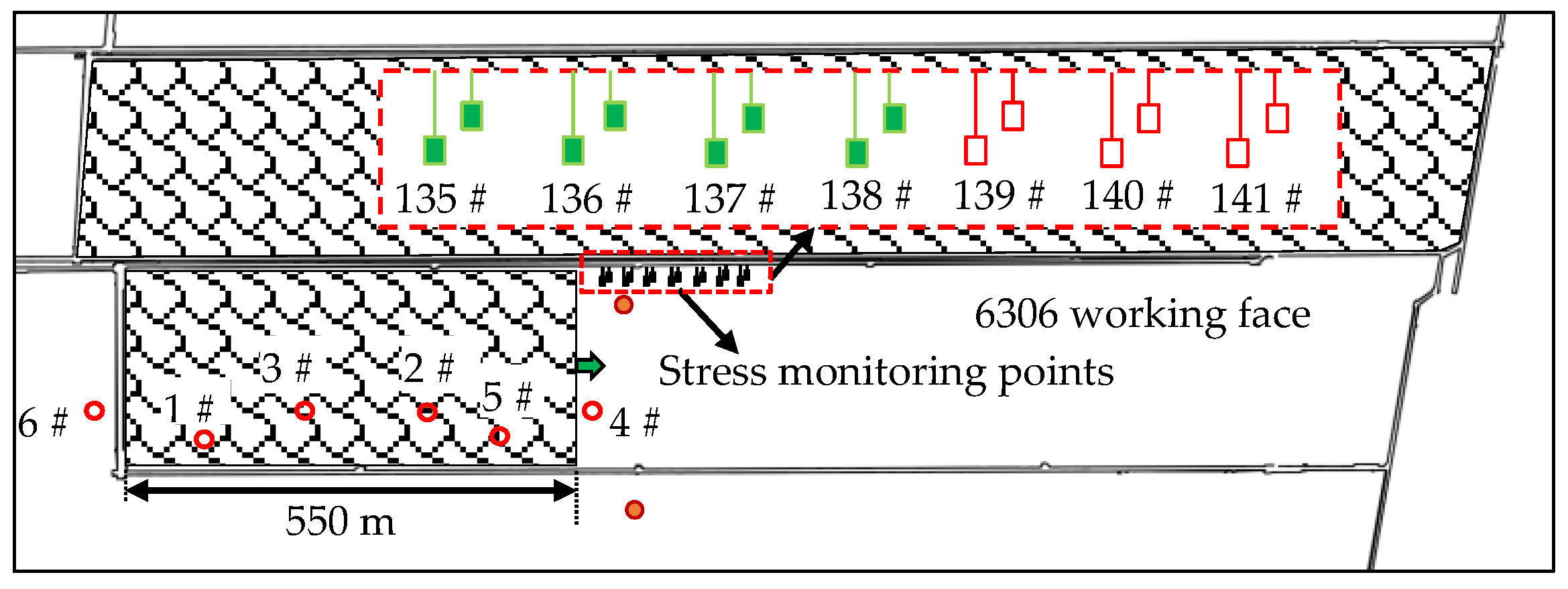

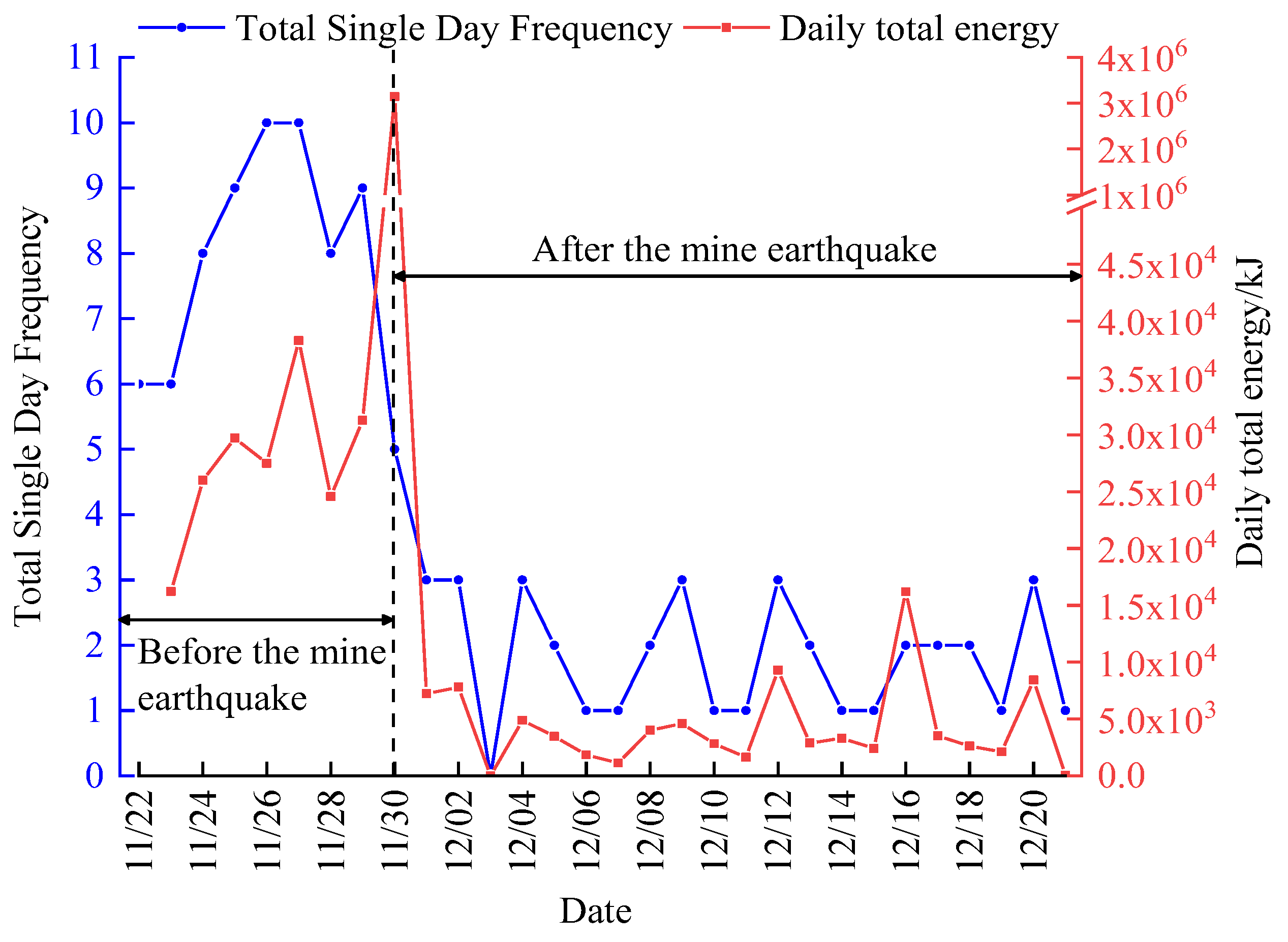

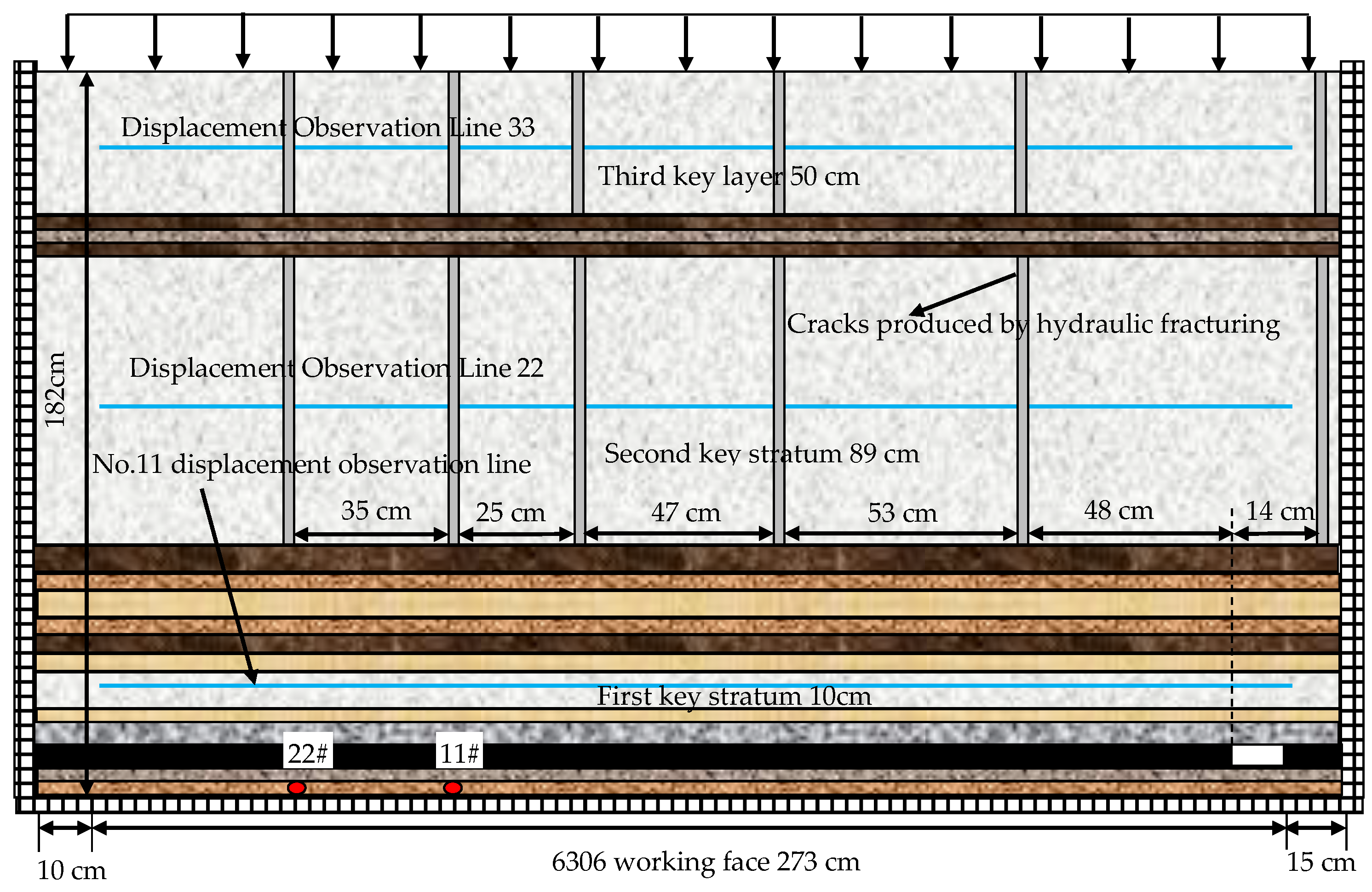

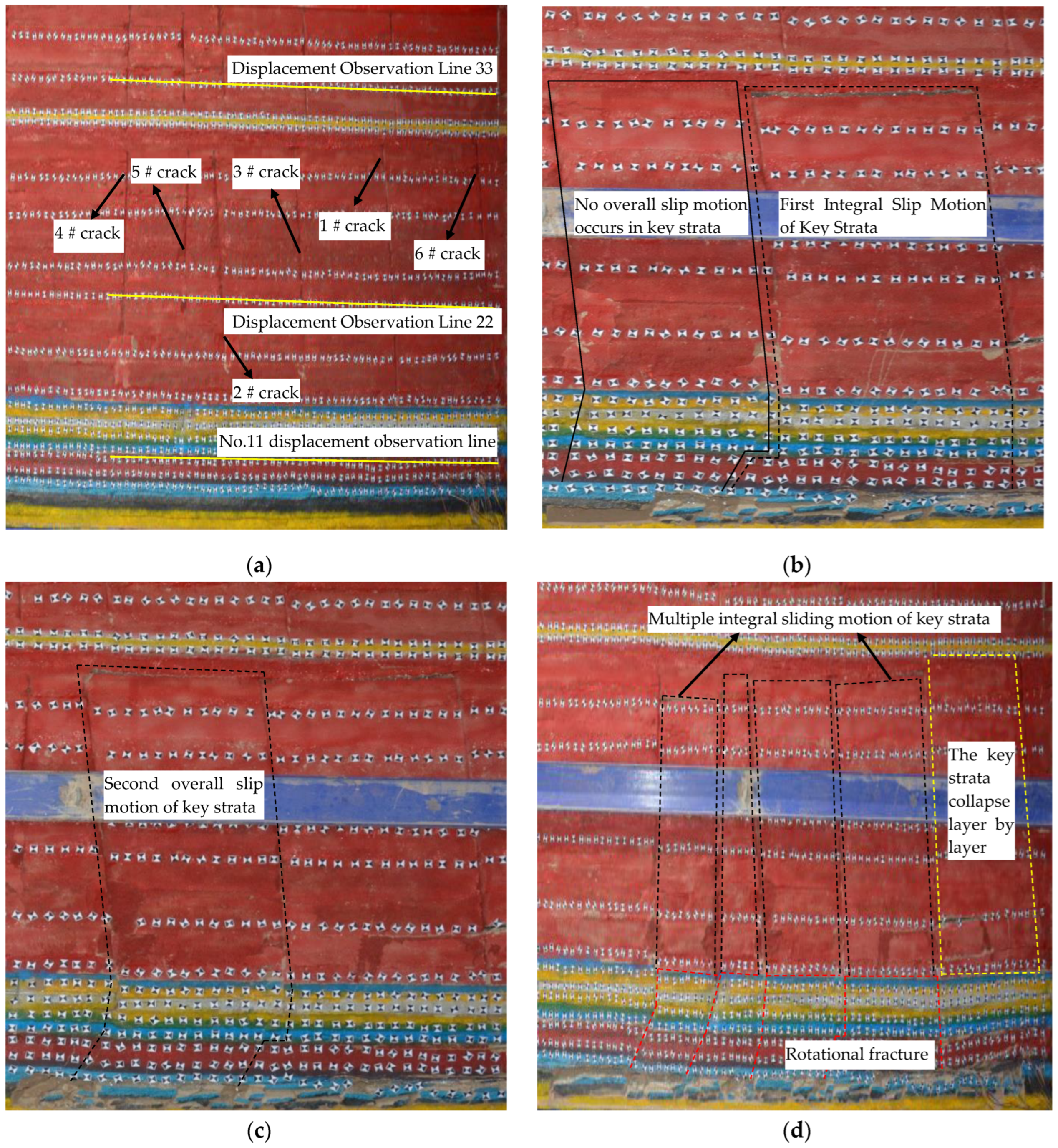

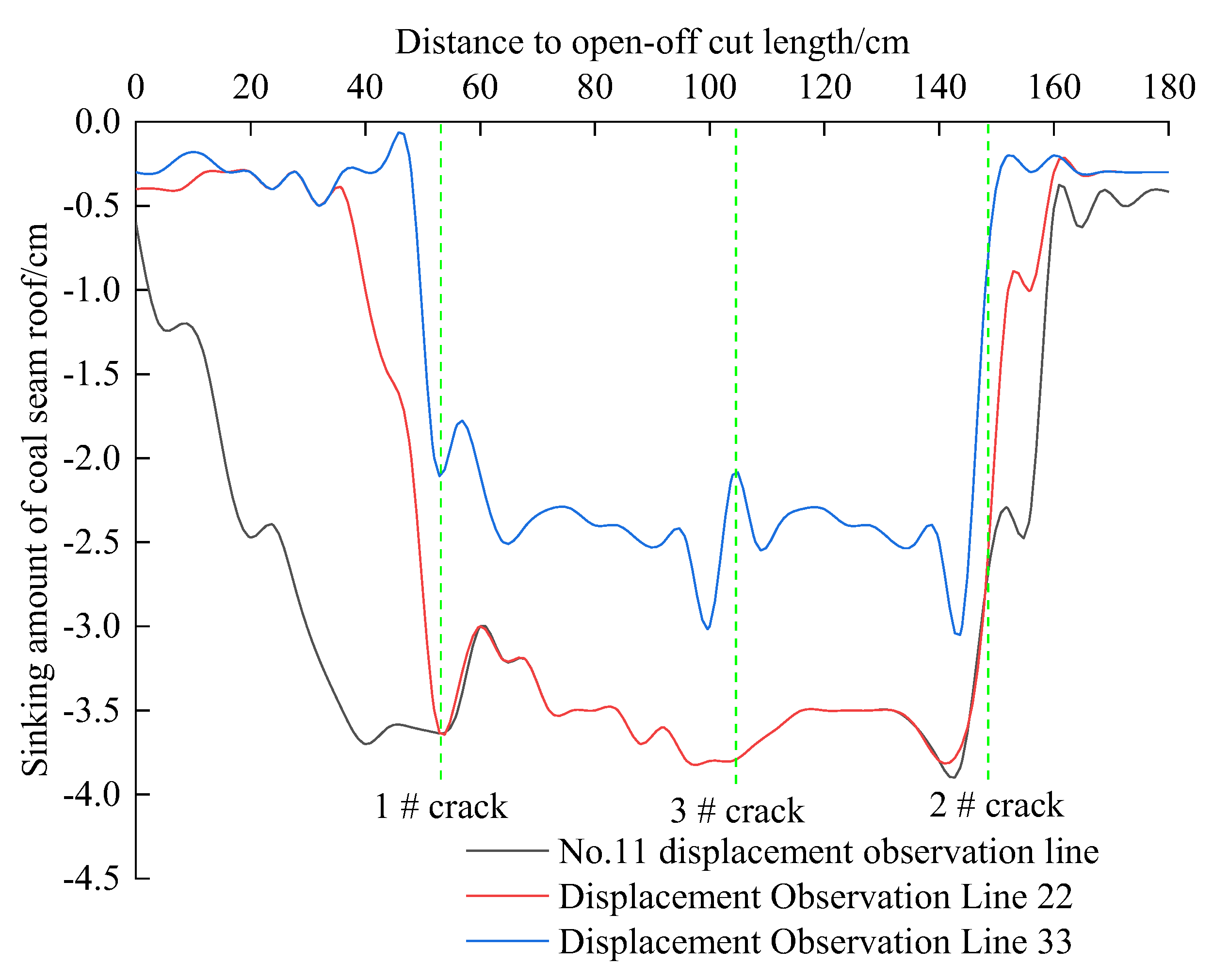
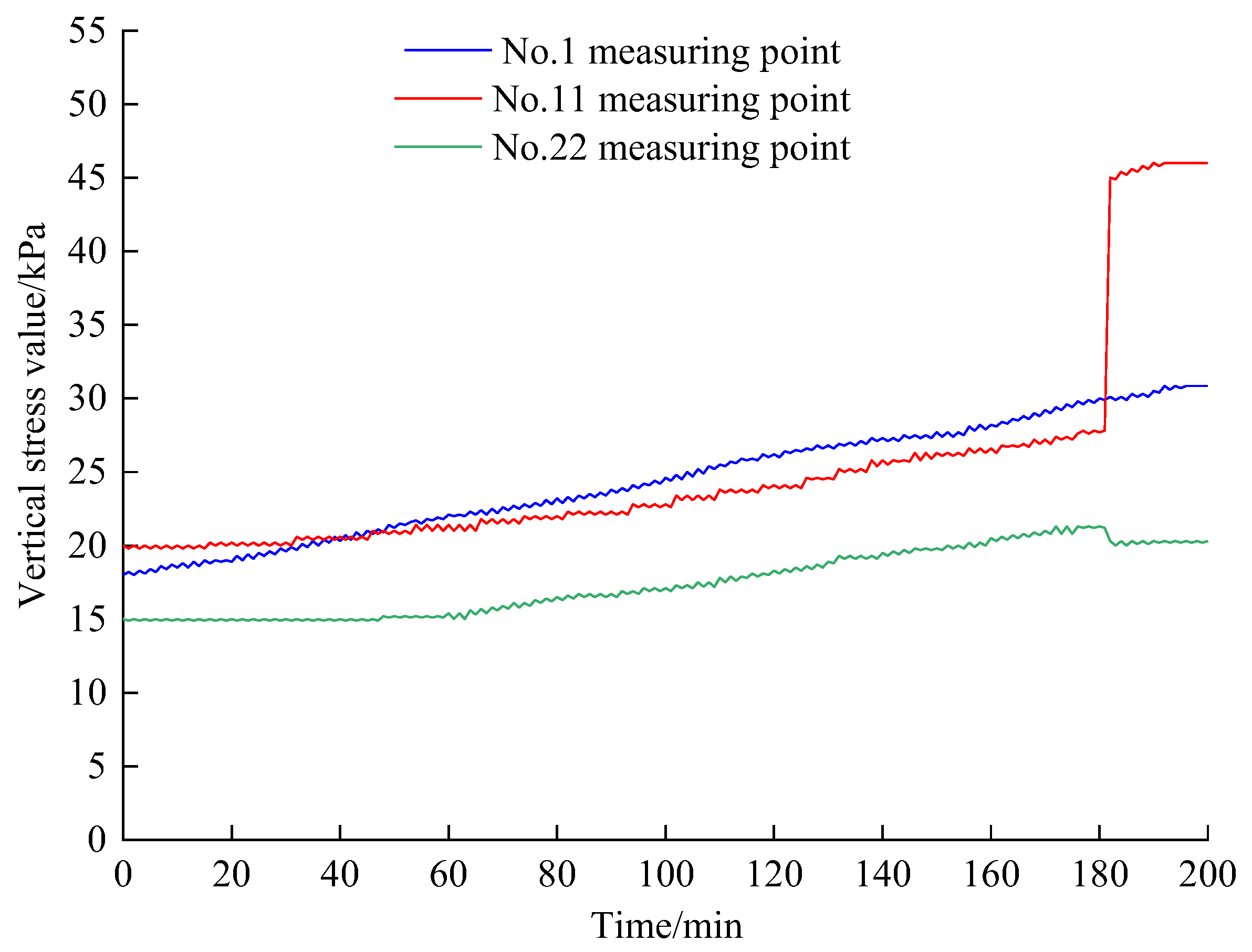
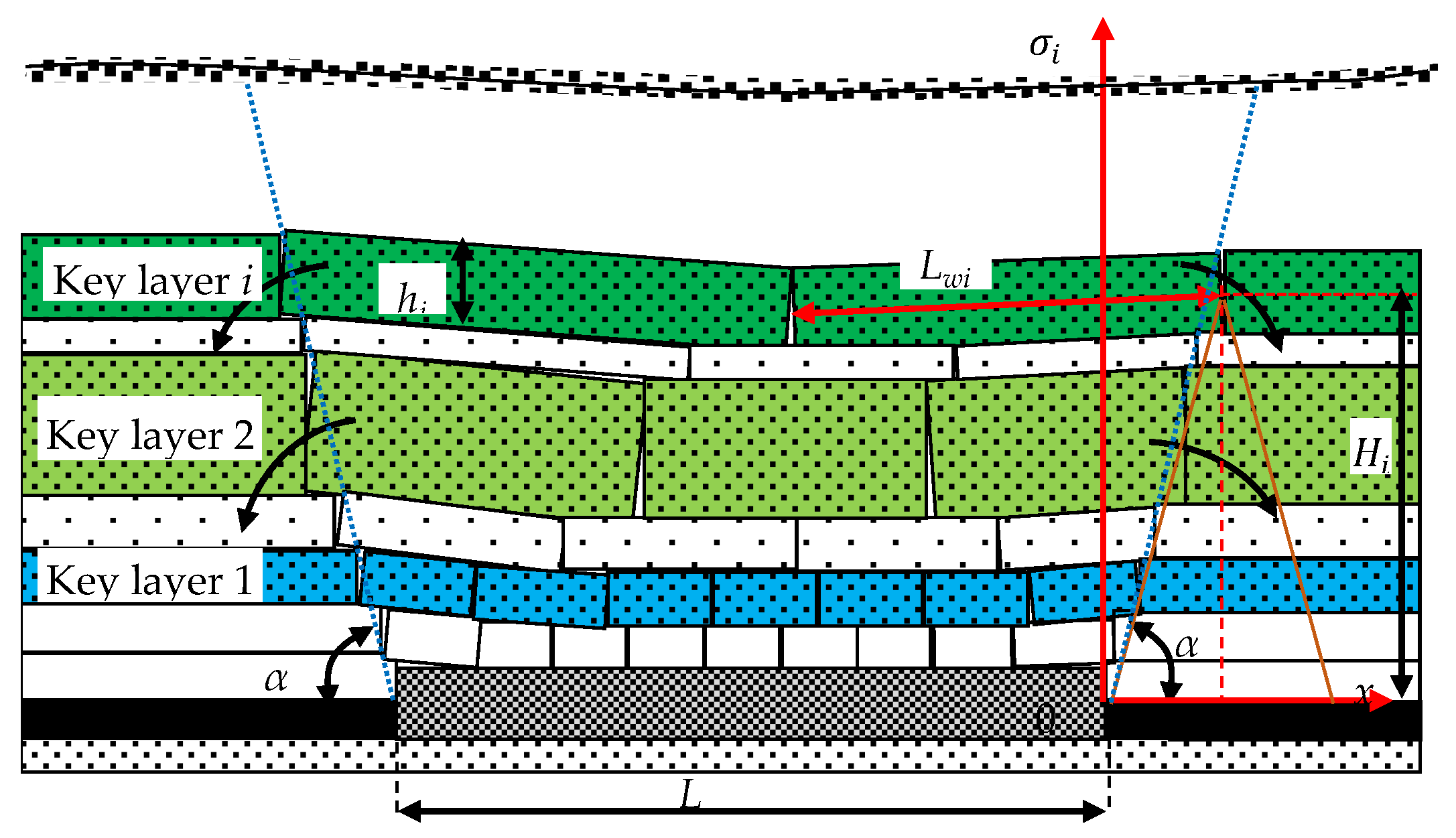
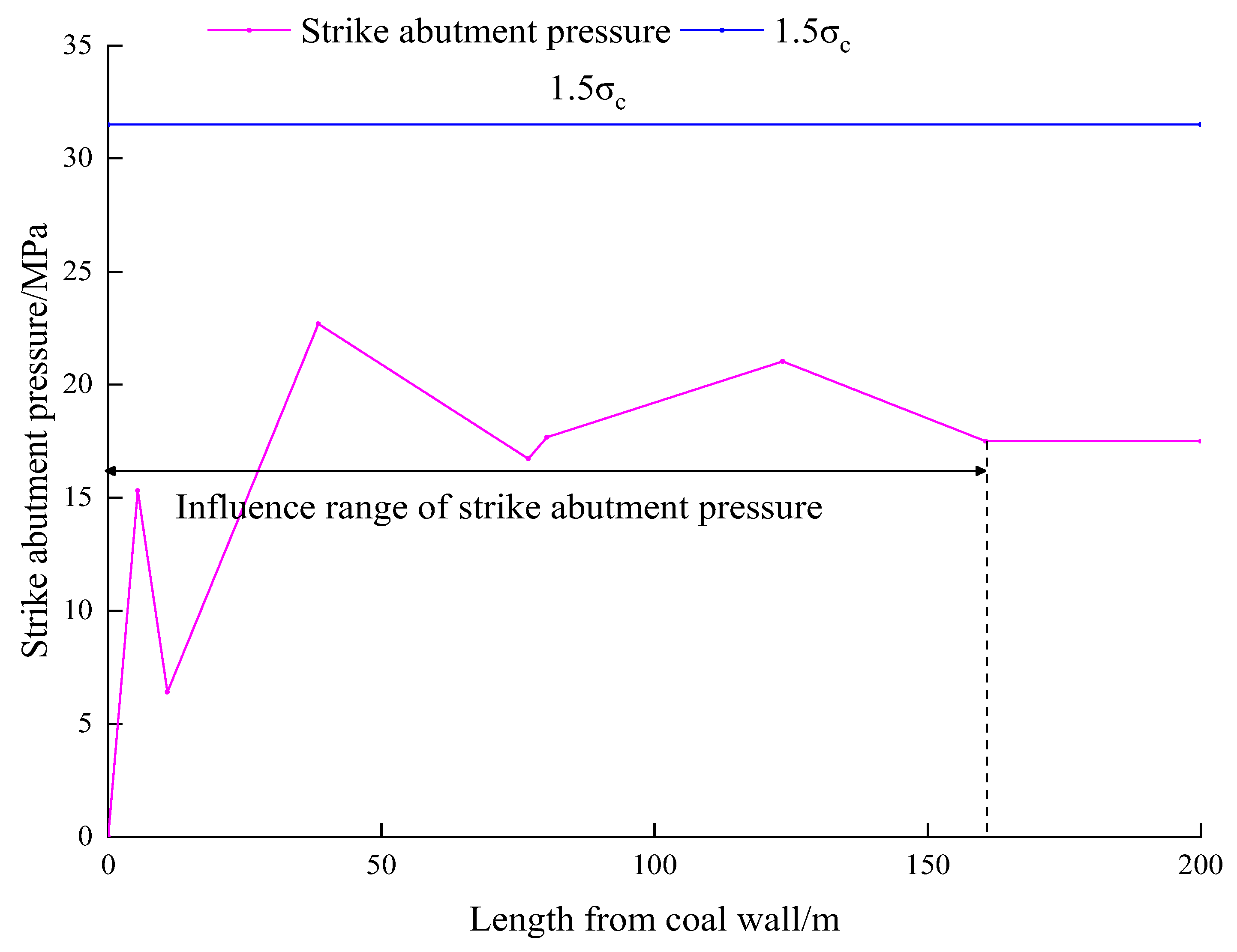

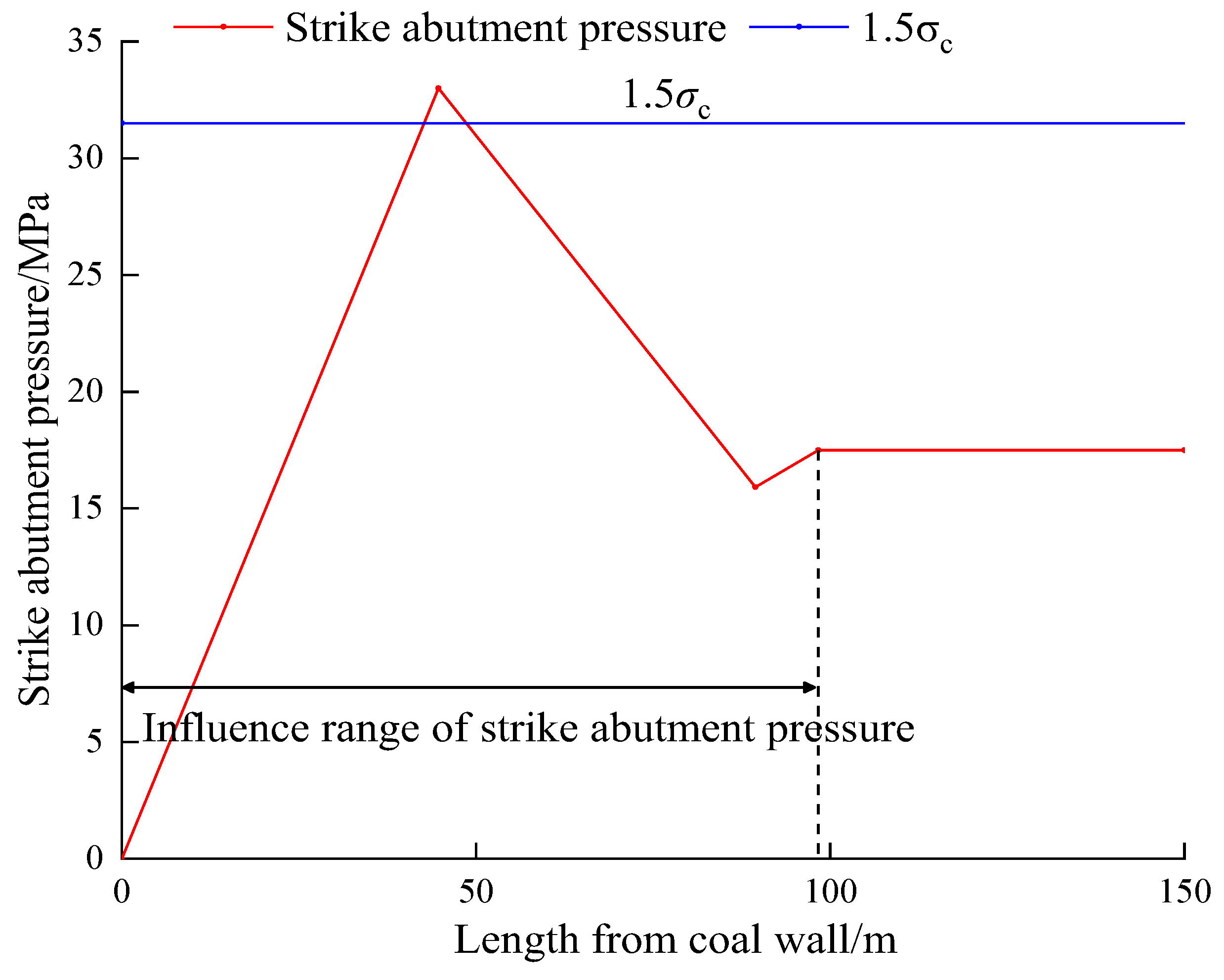

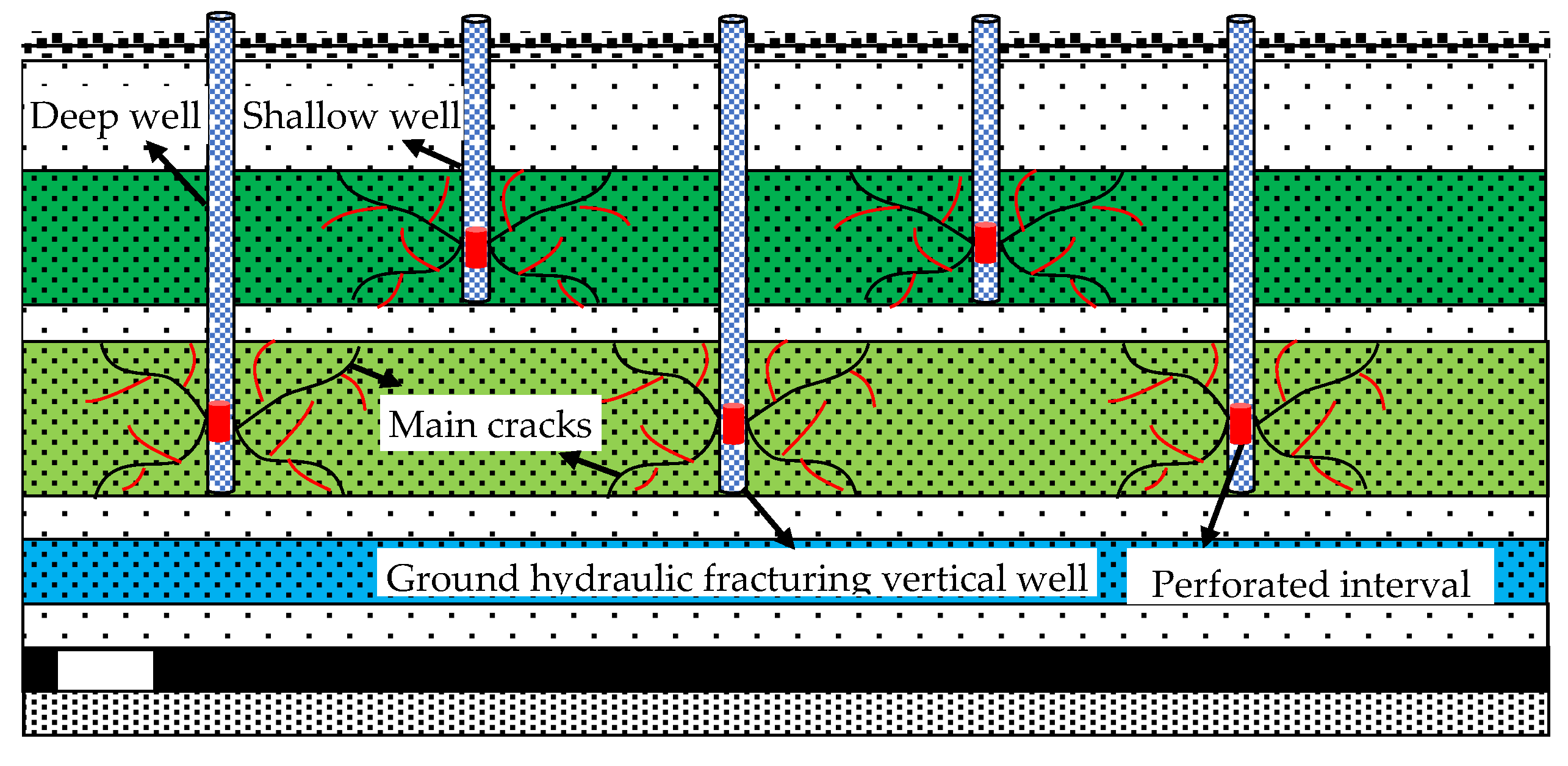

| Numbering | Rock | Thickness/m |
|---|---|---|
| 23 | quaternary topsoil layer | 125.9 |
| 22 | sandstone group | 189.2 |
| 21 | sandy mudstone | 1.5 |
| 20 | sandstone | 8.2 |
| 19 | sandy mudstone | 1.3 |
| 18 | sandstone group | 263.4 |
| 17 | sandy mudstone | 12.6 |
| 16 | sandstone | 1.25 |
| 15 | mudstone | 0.95 |
| 14 | sandstone | 0.9 |
| 13 | mudstone | 4.4 |
| 12 | sandstone | 9.9 |
| 11 | sandy mudstone | 9 |
| 10 | mudstone | 2.05 |
| 9 | sandstone group | 29 |
| 8 | mudstone | 3.3 |
| 7 | 2 coal | 1.7 |
| 6 | mudstone | 1.6 |
| 5 | sandstone | 3.9 |
| 4 | medium-grained sandstone | 0.8 |
| 3 | fine sandstone | 2.5 |
| 2 | medium-grained sandstone | 0.5 |
| 1 | sandstone | 2.0 |
| 0 | 3 coal | 5.4 |
| Rock | Thickness of Stratum | Simulated Thickness | Compressive Strength | Simulated Strength | The Amount of Material | |||
|---|---|---|---|---|---|---|---|---|
| Fine Sand | Calcium Carbonate | Gypsum | Water | |||||
| sandstone group | 80 | 0.5 | 43.99 | 0.24 | 136.91 | 3.42 | 13.69 | 17.11 |
| sandy mudstone | 1.5 | 0.01 | 105.06 | 0.58 | 2.59 | 0.26 | 0.39 | 0.36 |
| fine sandstone | 8.2 | 0.03 | 43.99 | 0.24 | 8.21 | 0.21 | 0.82 | 1.03 |
| sandy mudstone | 1.3 | 0.01 | 105.06 | 0.58 | 2.59 | 0.26 | 0.39 | 0.36 |
| sandstone group | 263.4 | 0.89 | 47.38 | 0.26 | 239.71 | 8.99 | 20.97 | 29.96 |
| sandy mudstone | 12.6 | 0.04 | 70.88 | 0.39 | 11.53 | 0.82 | 0.82 | 1.46 |
| sandstone | 3.1 | 0.01 | 46.76 | 0.26 | 2.70 | 0.10 | 0.24 | 0.34 |
| mudstone | 4.4 | 0.02 | 105.06 | 0.58 | 5.17 | 0.52 | 0.78 | 0.72 |
| sandstone | 9.9 | 0.03 | 37.89 | 0.21 | 8.15 | 0.20 | 0.81 | 1.02 |
| sandy mudstone | 9 | 0.03 | 106.58 | 0.59 | 7.88 | 0.79 | 1.18 | 1.09 |
| mudstone | 2.05 | 0.01 | 70.88 | 0.39 | 2.88 | 0.21 | 0.21 | 0.37 |
| sandstone group | 29 | 0.1 | 106.58 | 0.59 | 26.26 | 2.63 | 3.94 | 3.65 |
| mudstone | 6.6 | 0.02 | 37.89 | 0.21 | 5.43 | 0.14 | 0.54 | 0.68 |
| siltstone | 9.7 | 0.03 | 74.88 | 0.416 | 8.65 | 0.62 | 0.62 | 1.10 |
| 3 coal | 5.4 | 0.03 | 21 | 0.116 | 5.05 | 0.51 | 0.13 | 0.63 |
| fine sandstone | 12 | 0.04 | 37.89 | 0.21 | 10.86 | 0.27 | 1.09 | 1.36 |
| fine sandstone | 6 | 0.02 | 37.89 | 0.21 | 5.43 | 0.14 | 0.54 | 0.68 |
Publisher’s Note: MDPI stays neutral with regard to jurisdictional claims in published maps and institutional affiliations. |
© 2022 by the authors. Licensee MDPI, Basel, Switzerland. This article is an open access article distributed under the terms and conditions of the Creative Commons Attribution (CC BY) license (https://creativecommons.org/licenses/by/4.0/).
Share and Cite
Shang, X.; Zhu, S.; Jiang, F.; Liu, J.; Li, J.; Hitch, M.; Liu, H.; Tang, S.; Zhu, C. Study on Dynamic Disaster Mechanisms of Thick Hard Roof Induced by Hydraulic Fracturing in Surface Vertical Well. Minerals 2022, 12, 1537. https://doi.org/10.3390/min12121537
Shang X, Zhu S, Jiang F, Liu J, Li J, Hitch M, Liu H, Tang S, Zhu C. Study on Dynamic Disaster Mechanisms of Thick Hard Roof Induced by Hydraulic Fracturing in Surface Vertical Well. Minerals. 2022; 12(12):1537. https://doi.org/10.3390/min12121537
Chicago/Turabian StyleShang, Xiaoguang, Sitao Zhu, Fuxing Jiang, Jinhai Liu, Jiajie Li, Michael Hitch, Hongliang Liu, Shibin Tang, and Chun Zhu. 2022. "Study on Dynamic Disaster Mechanisms of Thick Hard Roof Induced by Hydraulic Fracturing in Surface Vertical Well" Minerals 12, no. 12: 1537. https://doi.org/10.3390/min12121537
APA StyleShang, X., Zhu, S., Jiang, F., Liu, J., Li, J., Hitch, M., Liu, H., Tang, S., & Zhu, C. (2022). Study on Dynamic Disaster Mechanisms of Thick Hard Roof Induced by Hydraulic Fracturing in Surface Vertical Well. Minerals, 12(12), 1537. https://doi.org/10.3390/min12121537











